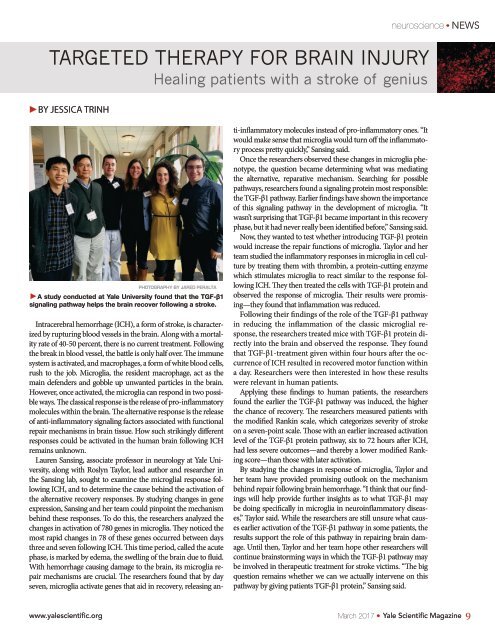YSM Issue 90.2
Create successful ePaper yourself
Turn your PDF publications into a flip-book with our unique Google optimized e-Paper software.
neuroscience<br />
NEWS<br />
TARGETED THERAPY FOR BRAIN INJURY<br />
Healing patients with a stroke of genius<br />
►BY JESSICA TRINH<br />
PHOTOGRAPHY BY JARED PERALTA<br />
►A study conducted at Yale University found that the TGF-β1<br />
signaling pathway helps the brain recover following a stroke.<br />
Intracerebral hemorrhage (ICH), a form of stroke, is characterized<br />
by rupturing blood vessels in the brain. Along with a mortality<br />
rate of 40-50 percent, there is no current treatment. Following<br />
the break in blood vessel, the battle is only half over. The immune<br />
system is activated, and macrophages, a form of white blood cells,<br />
rush to the job. Microglia, the resident macrophage, act as the<br />
main defenders and gobble up unwanted particles in the brain.<br />
However, once activated, the microglia can respond in two possible<br />
ways. The classical response is the release of pro-inflammatory<br />
molecules within the brain. The alternative response is the release<br />
of anti-inflammatory signaling factors associated with functional<br />
repair mechanisms in brain tissue. How such strikingly different<br />
responses could be activated in the human brain following ICH<br />
remains unknown.<br />
Lauren Sansing, associate professor in neurology at Yale University,<br />
along with Roslyn Taylor, lead author and researcher in<br />
the Sansing lab, sought to examine the microglial response following<br />
ICH, and to determine the cause behind the activation of<br />
the alternative recovery responses. By studying changes in gene<br />
expression, Sansing and her team could pinpoint the mechanism<br />
behind these responses. To do this, the researchers analyzed the<br />
changes in activation of 780 genes in microglia. They noticed the<br />
most rapid changes in 78 of these genes occurred between days<br />
three and seven following ICH. This time period, called the acute<br />
phase, is marked by edema, the swelling of the brain due to fluid.<br />
With hemorrhage causing damage to the brain, its microglia repair<br />
mechanisms are crucial. The researchers found that by day<br />
seven, microglia activate genes that aid in recovery, releasing anti-inflammatory<br />
molecules instead of pro-inflammatory ones. “It<br />
would make sense that microglia would turn off the inflammatory<br />
process pretty quickly,” Sansing said.<br />
Once the researchers observed these changes in microglia phenotype,<br />
the question became determining what was mediating<br />
the alternative, reparative mechanism. Searching for possible<br />
pathways, researchers found a signaling protein most responsible:<br />
the TGF-β1 pathway. Earlier findings have shown the importance<br />
of this signaling pathway in the development of microglia. “It<br />
wasn’t surprising that TGF-β1 became important in this recovery<br />
phase, but it had never really been identified before,” Sansing said.<br />
Now, they wanted to test whether introducing TGF-β1 protein<br />
would increase the repair functions of microglia. Taylor and her<br />
team studied the inflammatory responses in microglia in cell culture<br />
by treating them with thrombin, a protein-cutting enzyme<br />
which stimulates microglia to react similar to the response following<br />
ICH. They then treated the cells with TGF-β1 protein and<br />
observed the response of microglia. Their results were promising—they<br />
found that inflammation was reduced.<br />
Following their findings of the role of the TGF-β1 pathway<br />
in reducing the inflammation of the classic microglial response,<br />
the researchers treated mice with TGF-β1 protein directly<br />
into the brain and observed the response. They found<br />
that TGF-β1-treatment given within four hours after the occurrence<br />
of ICH resulted in recovered motor function within<br />
a day. Researchers were then interested in how these results<br />
were relevant in human patients.<br />
Applying these findings to human patients, the researchers<br />
found the earlier the TGF-β1 pathway was induced, the higher<br />
the chance of recovery. The researchers measured patients with<br />
the modified Rankin scale, which categorizes severity of stroke<br />
on a seven-point scale. Those with an earlier increased activation<br />
level of the TGF-β1 protein pathway, six to 72 hours after ICH,<br />
had less severe outcomes—and thereby a lower modified Ranking<br />
score—than those with later activation.<br />
By studying the changes in response of microglia, Taylor and<br />
her team have provided promising outlook on the mechanism<br />
behind repair following brain hemorrhage. “I think that our findings<br />
will help provide further insights as to what TGF-β1 may<br />
be doing specifically in microglia in neuroinflammatory diseases,”<br />
Taylor said. While the researchers are still unsure what causes<br />
earlier activation of the TGF-β1 pathway in some patients, the<br />
results support the role of this pathway in repairing brain damage.<br />
Until then, Taylor and her team hope other researchers will<br />
continue brainstorming ways in which the TGF-β1 pathway may<br />
be involved in therapeutic treatment for stroke victims. “The big<br />
question remains whether we can we actually intervene on this<br />
pathway by giving patients TGF-β1 protein,” Sansing said.<br />
www.yalescientific.org<br />
March 2017<br />
Yale Scientific Magazine<br />
9


















